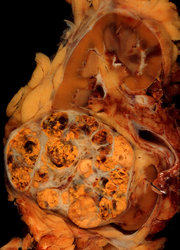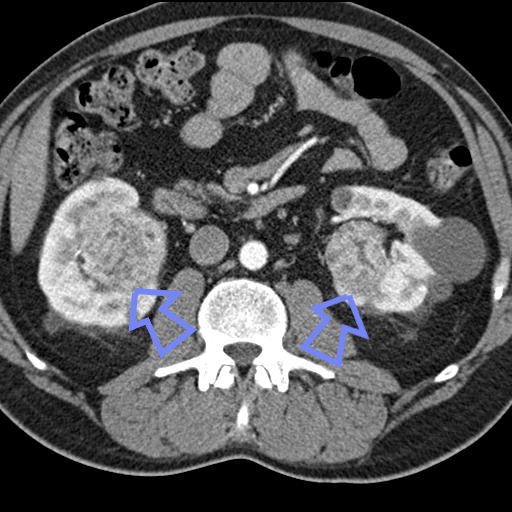Renal cell carcinoma
Renal cell carcinoma, also known by the eponym Grawitz tumor, is the most common form of kidney cancer arising from the renal tubule. It is the most common type of kidney cancer in adults. Initial therapy is with surgery. more...
It is notoriously resistant to radiation therapy and chemotherapy, although some cases respond to immunotherapy.
Signs and symptoms
The classic triad is hematuria (blood in the urine), flank pain and an abdominal mass. This "classic triad" is infrequently present when the patient first presents for medical attention.
Other signs may include:
- Abnormal urine color (dark, rusty, or brown) due to blood in the urine
- Weight loss of more than 5% of body weight with emaciated, thin, malnourished appearance
- More and more frequently, renal cell carcinoma is identified as an incidental finding on a medical imaging study of the abdomen (e.g. computed tomography a.k.a. CT) done for an unrelated purpose
- The presenting symptom may be due to to metastatic disease, such as a pathologic fracture of the hip due to a metastasis to the bone
- Enlargement of one testicle (usually the left, due to blockage of the left gonadal vein by tumor invasion of the left renal vein -- the right gonadal vein drains directly into the inferior vena cava)
- Paraneoplastic phenomena (not directly due to the mass, but due to secreted substances with hormonal activity):
- Vision abnormalities
- Pallor or plethora
- Excessive hair growth (females)
- Constipation
- Cold intolerance
- High blood pressure
Causes
Renal cell carcinoma affects about three in 10,000 people, resulting in about 31,000 new cases in the US per year. Every year, about 12,000 people in the US die from renal cell carcinoma. It is more common in men than women, usually affecting men older than 55.
Why the cells become cancerous is not known. A history of smoking greatly increases the risk for developing renal cell carcinoma. Some people may also have inherited an increased risk to develop renal cell carcinoma, and a family history of kidney cancer increases the risk.
People with von Hippel-Lindau disease, a hereditary disease that also affects the capillaries of the brain, commonly also develop renal cell carcinoma. Kidney disorders that require dialysis for treatment also increase the risk for developing renal cell carcinoma.
Pathology
Gross examination shows a hypervascular lesion in the renal cortex, which is frequently multilobulated, yellow (because of the lipid accumulation) and calcified.
Light microscopy shows tumor cells forming cords, papillae, tubules or nests, and are atypical, polygonal and large. Because these cells accumulate glycogen and lipids, their cytoplasm appear "clear", lipid-laden, the nuclei remain in the middle of the cells, and the cellular membrane is evident. Some cells may be smaller, with eosinophilic cytoplasm, resembling normal tubular cells. The stroma is reduced, but well vascularized. The tumor grows in large front, compressing the surrounding parenchyma, producing a pseudocapsule.
Read more at Wikipedia.org




